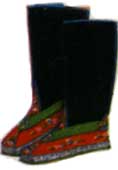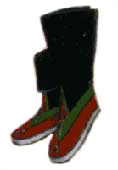Felt
Nomadic Tibetan tribes subsisted on, the wealth of their flocks of cattle, camels, sheep, goats, and horses. The existence of wool-furnishing domestic animals like sheep, goat and camel allowed Tibetan tribes to manufacture and utilize felt. [5]
Production of Felt
Rockhill is largely responsible for our knowledge of the production of felt in Tibet. He describes the production of felt as follows:
“Its mode of manufacture is extremely simple. The wool, having been first picked over, is spread out a handful at a time on a large piece of felt on the ground, each handful overlapping the preceding one in such a way that a piece of uniform thickness and of whatever size desired is made. This is rolled up tightly and with much pounding of the closed fist and then unrolled, and this work is kept up for an hour or more; then the roll is soaked in water and the work of rolling, unrolling, kneading and beating with the closed fist goes on for another hour or two. I was told that a piece of felt had to be kneaded at least 1,000 times before it was ready for use. After the role has been left to dry for a while it is opened, and by pulling it slightly in different directions the surface is made smooth, and the edges are trimmed with a knife. Sometimes it is bleached. Altogether, Tibetan and Mongol felt is vastly inferior to that made by the Chinese.” [6]
Boots made of Felt 
Felt boots resemble the “floppy turned down boots” worn in England during the 17th century. [7] As described by British archaeologist and army enginner Sir Alexander Cunningham, “The upper part of the felt boot is open to the front and is allowed to fall over.” [8] A garter could be used to bind the boot tightly below the knee. 
Felt boots are often trimmed with colored patches, “the lower part white, then red and green.” [9] The soles of felt boots are made of leather and (similar to leather boots), felt boots are lined with woolen cloth.
[5] The Early History of Felt by B. Laufer P. 1
[6] Notes on the Ethnology of Tibet by W.W. Rockhill P. 700
[7] http://people.ucsc.edu/~kfeinste/history.html
[8] Notes on the Ethnology of Tibet by W.W. Rockhill P. 687
[9] The Early History of Felt by B. Laufer P. 7
